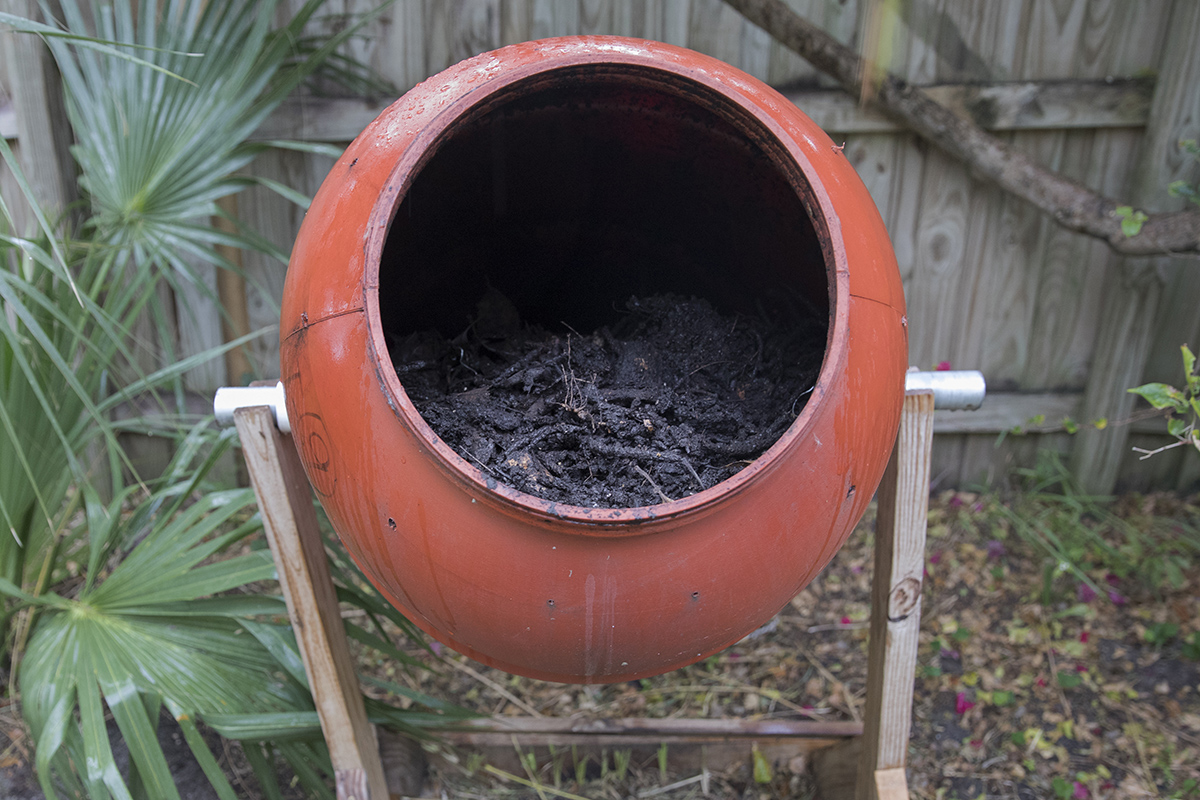No Yard? No Problem: You Can Still Compost at Home

Composting is a natural practice that dates all the way back to biblical times. It’s a contained form of decay that provides a nutrient-rich fertilizer — meaning one less expense for your garden.
It’s also an important and easy thing we can do for the environment: The Environmental Protection Agency estimates that food scraps and yard waste currently total 30% of what gets thrown away.
Most composters create a pile in their backyard, typically next to their garden. But eco-minded families with small yards, or even no yard, can compost at home and use the fertilizer for indoor plants or donate it to a local community garden.
What You Can Compost
Composting is all about layering: To help with drainage, the first layer should be twigs or grass. Then, according to Gena Loraine, horticulturist at Fantastic Services, you need to “alternate between green and brown layers. Keep the ratio 50-50. First, add a green layer, then a brown one, and keep it moist by adding water.”
Green Layers
Green layers include green yard waste like grass clippings and plant materials as well as coffee grounds, tea bags, fruit and vegetable scraps, eggshells and even flat beer.
Brown Layers
Brown layers include dead leaves and tree branches, shredded paper (think of all that junk mail), egg cartons, cardboard, sawdust and wine corks.
Save More Money Beyond Composting
Have you already saved some money by learning how to compost? We’ve got a few more ways for you to save some green. Fro saving on interest to car insurance, here are some of our favorite ways.
| Offer | Why We Like It | What You Need to Do | Start Saving |
|---|---|---|---|
| The Penny Hoarder Auto Insurance Tool | Save ~$500 per year | Provide some basic information | |
| AmOne | Save on interest payments with a personal loan | Answer a 10 quick qualifying questions | |
| Balance Transfer Credit Cards* | Cancel Your Interest Payments Until 2026 | Apply for a 0% Interest Credit Card | |
| Upside | Save $40/month on Gas | Download this free app |
What You Can’t Compost
There are several items you should not compost: Cooking grease or oil, dairy products and meat/fish scraps, including bones.
Too much water can also be counterproductive. Keep it moist with water from your hose, but if rain is in the forecast, cover your pile or bin with a tarp. You should also regularly cover your compost with wood or carpet scraps to retain moisture and heat.
“As soon as you are done [layering], the mixture will start to heat up,” Loraine explained. “You can use a meat thermometer to keep checking the temperature as it rises. It should be between 49 and 77 degrees Celsius (120 to 170 degrees Fahrenheit). If [the temperature] falls down, just stir it a little bit.”
In fact, weekly stirring with a shovel or pitchfork is crucial.
“Stir the mixture often to speed the process,” Loraine said. “Don’t leave your pile alone and just wait. It may take several months to a year to be ready.”
“You will know that the pile is done when it stops heating up,” she adds. “It should be just like dirt, with an earthy smell, and dark brown in color.”

How to Start a Compost Pile in Your Yard
If you own or rent a house with a backyard, you can most definitely compost. You can either create a compost pile or use a bin, but location matters.
In the northern half of the U.S., consider a place where your pile or bin will get more sunlight; in the southern half, scout out a spot that offers some shade. For convenience, keep it close to the area(s) you’ll be using the resulting fertilizer and ensure you can reach it with your garden hose.
If you have a small backyard, Loraine suggests talking to your neighbors first.
“Make sure they don’t mind you making your own compost,” she said. “It may produce a slight smell; however, well-managed compost piles do not smell.”
If creating a pile, make sure it has contact with the ground soil to allow the necessary organisms to naturally find their way up. Composting on a slab of concrete will prohibit worms and other organisms from easily accessing the pile.
If using a bin, Loraine advised it should be square or cone-shaped. She emphasizes that ventilation is also important to the process.
One major deterrent to regularly composting is the inconvenience. When you crack an egg or empty your coffee maker, you are usually within an arm’s reach of your trash can, but you may have a significant walk outside, in extreme temperatures or weather, to dispose of your kitchen waste.
The solution? Keep a small compost bin under your kitchen sink. Summer Rayne Oakes, founder of Homestead Brooklyn, says, “If you want, you can line it with a compostable ‘plastic’ bag or a paper bag, and you can store your food waste in there. Some compost bins have a charcoal filter at the top to prevent air from seeping out.”
Then, when the weather is nice or you’re already making a trek out back, simply grab the contents of the small bin and add it to your outdoor compost.

How to Compost Without a Yard — and With Worms
Not everyone has the luxury of a large backyard. If you have a small yard (or perhaps no yard), you can still recycle your kitchen scraps via composting.
“If you live in an apartment, choose a plastic or ceramic container. Poke holes in the lid and the bottom of the box. This will provide ventilation and will allow the water to drain,” Loraine said. “Before layering your scraps, cut strips of paper. Soak them in water and coat the bottom of your container. Pour some soil on top of it, and add red wiggler worms. Your bin should be one square foot per every pound of worms. Cover your compost pile with soaked paper strips every time you add scraps to it.”
And if you think that Loraine is off her rocker for bringing worms into her home, you should know that other experts agree.
Rayne tells me a similar story: “I have no backyard, so I have a vermicomposter, which is a fancy term for ‘worm composting,’ under my kitchen sink. You can either purchase one or make one yourself, and it’s actually nice to have, particularly if you have plants indoors or on your balcony, because even though worm composting indoors is slower, you can get some really rich soil additives in place.”
If composting with worms inside your home isn’t your cup of compost tea, you can still save your food scraps to donate. After food waste spends a few days inside your DIY compost bin under the sink, “you can add this waste to a paper bag that you can store in your freezer,” Rayne explains. “This is what I do, and eventually, I take that to the farmers market here to get properly composted, or I can take it to a local organization that does composting.”
Looking for more ways to save by composting? Research to see if your city offers any rebates or other incentives to residents who compost.
Contributor Timothy Moore is a writer and editor in Cincinnati. He focuses on banks, loans and insurance plus automotive stories for The Penny Hoarder. His work has been featured on USA Today, Forbes, INSIDER, LendEDU, Chime, SoFi and Retirement Living.












